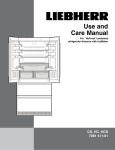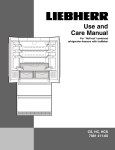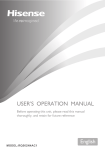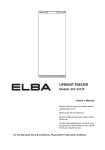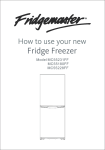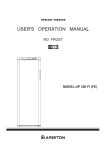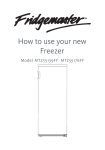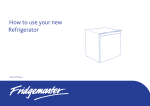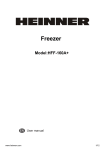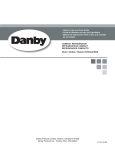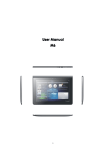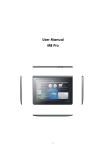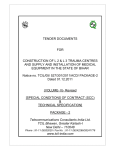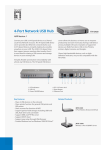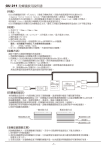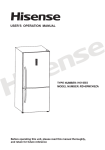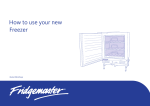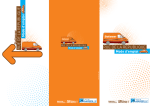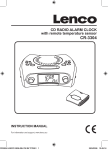Download MC55250 Combi Fridge Freezer
Transcript
Model MC55250 2 Contents Safety and warning information_ __ _ _ _ _ 2 Installing your new appliance_ _ _ _ _ _ _ _ 7 Reversing the door _ _ _ _ _ _ _ _ _ _ _ _ _ 8 Using your appliance_ __ _ _ _ _ _ _ _ _ _ _ 12 Helpful hints and tips__ _ _ _ _ _ _ _ _ _ _ _ 12 Cleaning and Care _ _ _ _ _ _ _ _ _ _ _ _ _ 13 Description of the appliance _ _ _ _ _ _ _ _10 Troubleshooting _ _ _ _ _ _ _ _ _ _ _ 15 Operation _ _ _ _ _ _ _ _ _ _ _ _ _ _ _ _ _ _ 11 Disposal of the appliance_ _ _ _ _ _ _ _ _ _ 16 This appliance is in accordance with the following EU guidelines:2006/95/EC and 2004/108/EC and 2009/125/EC and EC.643/2009 and 2002/96/EC For your safety and correct usage, before installing and first using the appliance, read this user manual carefully, including its hints and warnings. To avoid unnecessary mistakes and accidents, it is important to make sure that all people using the appliance are thoroughly familiar with its operation and safety features. Save these instructions and be sure that they remain with the appliance if it is moved or sold, so that anyone using it throughout its life, will be properly informed on its usage and safety notices. For the safety of life and property, keep the precautions of these user's instructions as the manufacturer is not responsible for damages caused by omission. Safety for children and others who are vulnerable people This appliance can be used by children aged from 8 years and above and persons with reduced physical, sensory or mental capabilities or lack of experience and knowledge if they have been given supervision or instruction concerning use of the appliance in a safe way and understand the hazards involved. Children shall not play with the appliance. Cleaning and user maintenance shall not be made by children without supervision. Keep all packaging away from children as there is risk of suffocation. If you are discarding the appliance, pull the plug out of 3 of the socket, cut the connection cable (as close to the appliance as you can) and remove the door to prevent children playing from suffering an electric shock or from closing themselves inside it. If this appliance, featuring a magnetic door seals, is to replace an older appliance having a spring lock (latch) on the door or lid, be sure to make the spring lock unusable before you discard the old appliance. This will prevent it from becoming a death trap for a child. General safety WARNING —This appliance is intended to be used in household and similar applications such as -staff kitchen areas in shops, offices and other working environments; -farm houses and by clients in hotels, motels and other residential type environments; -bed and breakfast type environments; -catering and similar nonretail applications WARNING — Do not store explosive substances such as aerosol cans with a flammable propellant in this appliance. WARNING — If the supply cord is damaged, it must be replaced by the manufacturer, its service agent or similarly qualified persons in order to avoid a hazard. WARNING — Keep ventilation openings, in the appliance enclosure or in the built-in structure, clear of obstruction. WARNING — Do not use mechanical devices or other means to accelerate the defrosting process, other than those recommended by the manufacturer. WARNING — Do not damage the refrigerant circuit. WARNING — Do not use electrical appliances inside the food storage compartments of the appliance, unless they are of the type recommended by the manufacturer. WARNING — The refrigerant and insulation blowing gas are flammable. When disposing of the appliance, do so only at an authorized waste disposal centre. Do not expose to flame. 4 Refrigerant The refrigerant isobutene (R600a) is contained within the refrigerant circuit of the appliance, a natural gas with a high level of environmental compatibility, which is nevertheless flammable. During transportation and installation of the appliance, ensure that none of the components of the refrigerant circuit becomes damaged. The refrigerant (R600a) is flammable. Caution:risk of fire If the refrigerant circuit should be damaged: -Avoid opening flames and sources of ignition. -Thoroughly ventilate the room in which the appliance is situated. It is dangerous to alter the specifications or modify this product in any way. Any damage to the cord may cause a shortcircuit, fire, and/or electric shock. Electrical safety 1.The power cord must not be lengthened. 2. Make sure that the power plug is not crushed or damaged. A crushed or damaged power plug may overheat and cause a fire. 3. Make sure that you can access the main plug of the appliance. 4. Do not pull the main cable. 5. If the power plug socket is loose, do not insert the power plug. There is a risk of electric shock or fire. 6.You must not operate the appliance without the interior lighting lamp cover. 7.The fridge is only applied with power supply of single phase alternating current of 220~240V/50Hz. If fluctuation of voltage in the district of user is so large that the voltage exceeds the above scope, for safety sake, be sure to apply A.C. Automatic voltage regulator of more than 350W to the fridge. The fridge must employ a special power socket instead of common one with other electric appliances. Its plug must match the socket with ground wire. 5 Daily use Do not store flammable gass or liquids in the appliance,There is a risk of an explosion. Do not operate any electrical appliances in the appliance(e.g.electric ice cream makers,mixers etc.). When unplugging always pull the plug from the mains socket,do not pull on the cable. Do not place hot items near the plastic components of this appliance. Store pre-packed frozen food in accordance with the frozen food manufacture’s instructions. The appliances manufactures storage recommendations should be strictly adhered to.Refer to relrelevant instructions for storage. Do not place carbonated or fizzy drinks in the freeze compartment as it creates pressure on the container,which may cause it to explode,resulting in damage to the appliance. Frozen food can cause frost burns if consumed straight from the freezer compartment. Do not place the appliance in direct sunlight. Keep buring candles,lamps and other items with naked flames away from the appliance so that do not set the appliance on fire. The appliance is intended for keeping food stuff and/or beverages in normal household as explained in this instruction booklet. The appliance is heavy.Care should be taken when moving it. Do not remove nor touch items from the freezer comartment if your hands are damp/wet,as this could cause skin abrasions or frost/freezer burns. Avoid prolonged exposure of the appliance to direct sunlight. Never use the base, drawers, doors etc. to stand on or as supports. Frozen food must not be refrozen once it has been thawed out. Do not consume ice popsicles or ice cubes straight from the freezer as this can cause freezer burn to the mouth and lips. To avoid items falling and causing injury or damage to the appliance, do not 6 overload the door racks or put too much food in the crisper drawers. Caution! Care and cleaning Before maintenance, switch off the appliance and disconnect the mains plug from the mains socket. Do not clean the appliance with metal objects, steam cleaner, ethereal oils, organic solvents or abrasive cleansers. Do not use sharp objects to remove frost from the appliance. Use a plastic scraper. Installation Important! For electrical connection carefully, follow the instructions given in this manual. Unpack the appliance and check if there are damages on it. Do not connect the appliance if it is damaged. Report possible damages immediately to the place you bought it. In this case retain packing. It is advisable to wait at least four hours before connecting the appliance to allow the oil to flow back in the compressor. Adequate air circulation should be around the appliance, lacking this leads to overheating. To achieve sufficient ventilation, follow the instructions relevant to installation. Wherever possible the back of the product should not be too close to a wall to avoid touching or catching warm parts (compressor, condenser) to prevent the risk of a fire, follow the instructions relevant to installation. The appliance must not be locate close to radiators or cookers. Make sure that the mains plug is accessible after the installation of the appliance. Service Any electrical work required to do the servicing of the appliance should be carried out by qualified electrician or competent person. This product must be serviced by an authorized Service Center, and only genuine spare parts must be used. 1)If the appliance is Frost Free. 2)If the appliance contains freezer compartment. 1139 636 1749 7 938 8 Reversing the door screw hole cover screw The side at which the door opens can be upper hinge cover (right) changed from the right side (as supplied) to the left side, if the installation site requires. Tools you will need: 1. 8mm socket driver 3.Unscrew the special flange self-tapping screws which are used for fixing the right upper hinge part by a 8mm socket driver or a spanner(please support the upper door with your hand when doing it ). 2. cross-shaped screwdriver special flange selftapping screws right upper hinge part 3. Putty knife or thin-blade screwdriver 4.Remove the upper hinge axis, transfer it to reversed side and tighten securely, then put it in a safe place. Before you start lay the refrigerator on it’s back in order to gain access to the base, you should rest it on soft foam packaging or similar material to avoid damaging the cooling pipes at the rear of the refrigerator. 1. Stand the refrigerator, open the upper door and remove the door shelves and close it(preventing the shelves are damaged ). 5.Lift the upper door and set it on a non scratching surface with the outside up NOTE: When removing the door, watch for washer(s) between the ceter hinge and the bottom of the freezer door that may stick to the door. Do not lose. 6.Unscrew the two special flange selftapping screws which are used for fixing the middle hinge part, then remove the middle hinge part that hold the lower door in place. middle hinge part 2. Use a putty knife or thin-blade screwdriver to prize the screw hole cover which is at the top left corner of the refrigerator, and Unscrew the upper hinge cover which is at the top right corner of the refrigerator. special flange selftapping screws 9 7. Lift the lower door and set it on a non scratching surface with the outside up NOTE: When removing the door, watch for washer(s) between the ceter hinge and the bottom of the freezer door that may stick to. the door. Do not lose. 12. Transfer the lower door to the property position, adjust the lower hinge part, make the hinge axis into the lower hole of the lower door, then tight the bolts. 8. Remove the screw hole cover from the left holes as illustrated and transfer them to the uncover holes at the right side. screw hole cover screw hole covers screw hole cover screw hole covers 9. Lay the refrigerator on soft foam packaging or similar material. Remove both adjustable bottom feet parts, and remove the front feet fixed board and the lower hinge part by unscrewing the special flange self-tapping screws. front feet fixed board 13. Upturn the middle hinge part the direction 180 degree, transfer it and adjust its position ,Make the middle hinge axis into the upper hole of the lower door, tight the bolts. lower hinge part ajustable bottom feet part special flange selftapping screws ajustable bottom feet part special flange selftapping screws 10. Unscrew the bottom hinge axis and remove it to the hole which is side-by-side and screw it. 11. Replace the lower hinge part to the left side and fixing it with the special flange selftapping screws. Replace the front feet fixed board to another side and fixing it with the special flange self-tapping screws. Install the ajustable bottom feet parts, lower hinge part front feet fixed board 14.Transfer the upper door to the appropriate position. Secure the door's level; make the middle hinge axis into the lower hole of the upper door. 10 15. Transfer the upper hinge part and make the upper hinge axis into the upper hole of the upper door,and adjust the position of the upper door(please support the upper door with your hand when doing it),fixing the upper hinge part with the special flange selftapping screws. upper hinge part 17. Open the upper door and install the door shelves, then close it. Warning! When changing the side at which the door opens, the appliance must not be connected to the mains. Remove plug from the mains beforehand. 18. 16. Install the screw hole cover on the top right corner of the refrigerator. Install the upper hinge cover (which is in the plastic bag) on the left corner and screw it.Put the other upper hinge cover into the plastic bag. screw upper hinge cover (left) screw hole cover Description of the appliance View of the appliance 1.Temperature regulator 2.Storage shelf. 3.Crisper Cover 4.Crisper 5.Upper Drawer in freezer 6.Middle Drawer in freezer 7.Lower Drawer in freezer 8.Upper Door rack 9.Lower Door rack 10.Ajustable bottom feet part 11.handles(only for the model with handles) 10 11 Operation Starting up and temperature regulation Changing the light bulb Warning! If the light bulb is damaged.DO NOT CHANG IT BY THE USER! Insert the plug of the connection lead into the plug socket with protective earth contact. When the refrigerator compartment door is opened, the internal lighting is switched on.After the fridge has been placed in position,wait for 5 minutes before electricity is supplied.Don't store anything until the temperature inside the fridge becomes low enough. Changing the light bulb carry out by inexperienced persons may cause injury or serious malfunctioning. it must be replaced by a qualified persons in order to avoid a hazard. Contact your local Service Force Center for help. The temperature selector knob is located on the top right of the refrigerator compartment. Before changing the light bulb, switch off the appliance and unplug it, or pull the fuse or the circuit breaker. Light bulb data: 220-240 V,max.15W. 5 Important! Normally we advise you select setting of 2 or 3 or 4, if you want the temperature higher or colder please turn the knob to warmer or colder setting accordingly. When you turn the knob to colder which can lead to the more energy efficiency. Otherwise, it would result the energyconsuming. Important! High ambient temperatures (e.g. on hot summer days) and a cold setting (position 6 to 7) may cause the compressor to run continuously or even non-stop! Reason: when the ambient temperature is high, the compressor must run continuously to maintain the low temperature in the appliance 4 3 To switch off the appliance, set the temperature regulator to position “0”. Unplug the mains plug To change the light bulb, undo the screw. Press the light bulb cover and slide it backwards. Change the defective light bulb. Refit the light bulb cover and the screw. Put the refrigerator back into operation. Bulb 5 Setting 0 means: Off. Clockwise rotate the knob to turn on the appliance Setting 1 means: Highest temperature, warmest setting. Setting 7 (end-stop) means: Lowest temperature, coldest setting. 4 3 Bulb cover Screw Control Box 12 Helpful hints and tips Energy saving tips We recommend that you follow the tips below to save energy. ● Try to avoid keeping the door open for long periods in order to conserve energy. ● Ensure the appliance is away from any sources of heat (Direct sunlight, electric oven or cooker etc) ● Don't set the temperature colder than necessary. ● Don't store warm food or evaporating liquid in the appliance. ● Place the appliance in a well ventilated, humidity free, room. Please refer to Installing your new appliance chapter. ● If the diagram shows the correct combination for the drawers, crisper and shelves, do not adjust the combination as this is designed to be the most energy efficient configuration. Hints for fresh food refrigeration ●Do not place hot food directly into the refrigerator or freezer, the internal temperature will increase resulting in the compressor having to work harder and will consume more energy. ● Do cover or wrap the food,particularly if it has a strong flavor. ● Place food properly so that air can circulate freely around it. Hints for refrigeration ● Meat (All Types) Wrap in polythene food: wrap and place on the glass shelf above the vegetable drawer. Always follow food storage times and use by dates suggested by manufacturers. ● Cooked food, cold dishes, etc.: They should be covered and may be placed on any shelf. ● Butter and cheese: Should be wrapped in airtight foil or plastic film wrap. 13 film wrap. Milk bottles: Should have a lid and be stored in the door racks. Hints for freezing ● When first starting-up or after a period out of use, let the appliance run at least 2 hours on the higher settings before putting food in the compartment. ● Prepare food in small portions to enable it to be rapidly and completely frozen and to make it possible to subsequently thaw only the quantity required. ● Wrap up the food in aluminum foil or polyethylene food wraps which are airtight, ● Do not allow fresh,unfrozen food to touch the food which is already frozen to avoid temperature rise of the latter. ● Iced products,if consumed immediately after removal from the freezer compartment, will probably cause frost burns to the skin. ● ● It is recommended to label and date each frozen package in order to keep track of the storage time. Hints for the storage of frozen food ● Ensure that frozen food has been stored correctly by the food retailer ● Once defrosted, food will deteriorate rapidly and should not be re-frozen. Do not exceed the storage period indicated by the food manufacturer. Switching off your appliance If the appliance needs to be switched off for an extended period, the following steps should be taken prevent mould on the appliance. 1. Remove all food. 2. Remove the power plug from the mains socket. 3. Clean and dry the interior thoroughly. 4. Ensure that all the doors are wedged open slightly to allow air to circulate. Cleaning and care For hygienic reasons the appliance (including exterior and interior accessories) should be cleaned regularly at least every two months. Caution! The appliance must not be connected to the mains during cleaning. Danger of electrical shock! Before cleaning switch the appliance off and remove the plug from the mains socket. Exterior cleaning To maintain good appearance of your appliance, you should clean it regularly. -Wipe the digital panel and display panel with a clean, soft cloth. -Spray water onto the cleaning cloth instead of spraying directly on the surface of the appliance. This helps ensure an even distribution of moisture to the surface. -Clean the doors, handles and cabinet surfaces with a mild detergent and then wiped dry with a soft cloth. Caution! -Don't use sharp objects as they are likely to scratch the surface. -Don't use Thinner, Car detergent, Clorox, ethereal oil, abrasive cleansers or organic For hygienic reasons the appliance (including exterior and interior accessories) should be cleaned regularly at least every two months. Caution! The appliance must not be connected to the mains during cleaning. Danger of electrical shock! Before cleaning switch the appliance off and remove the plug from the mains socket. solvent such as Benzene for cleaning. They may damage the surface of the appliance and may cause fire. Interior cleaning You should clean the appliance interior regularly. It will be easier to clean when food stocks are low. Wipe the inside of the fridge freezer with a weak solution of bicarbonate of soda, and then rinse with warm water using a wrung-out sponge or cloth. Wipe completely dry before replacing the shelves and baskets. Thoroughly dry all surfaces and removable parts. A layer of frost may occur on the freezer compartment's interior walls if the freezer door is opened frequently or kept open too 14 long. If the frost is too thick, choose a time when the supply of food stocks are low and proceed as follows: 1.Remove existing food and accessories baskets, unplug the appliance from the mains power and leave the doors open. Ventilate the room thoroughly to accelerate the thawing process. 2. When defrosting is completed, clean your freezer as described above. Caution! Don't use sharp objects to remove frost from the freezer compartment. Only after the interior is completely dry should the appliance be switched back on and plugged back into the mains socket. Door seals cleaning Take care to keep door seals clean. Sticky food and drinks can cause seals to stick to the cabinet and tear when you open the door. Wash seal with a mild detergent and warm water. Rinse and dry it thoroughly after cleaning. Caution! Only after the door seals are completely dry should the appliance be powered on. Defrosting Why defrosting Water contained in food or getting into air inside the fridge be opening doors may form a frost layer inside. It will weaken the refrigeration when the frost is thick. While it is more than 10mm thick, you should defrost. Defrosting in fresh food storage compartment It is automatically controlled by switching the temperature regulator on or off so that there is no need of operation of defrosting. Water from defrosting will be drained into an drip tray through a drain pipe at the back of the fridge automatically. Defrosting in frozen-food storage compartment Defrosting in freezer chamber is operated manually. Before defrosting, take the food out. Take the ice tray and food in drawers out or put them into the fresh food compartment temporarily. Set the knob of the temperature regulator to position “0”(where the compressor will stop working) and leave the door of the refrigerator open until ice and frost dissolve thoroughly and accumulation at the bottom of the freezer chamber. Wipe off the water with soft cloth. In the case of speeding up the process of defrosting, you may put a bowl of warm water (about 50°C) into the freezer chamber, and scrape away the ice and frost with a defrosting spatula. After doing so,be sure to set the knob of the temperature regulator to the original position. It is not advisable to heat the freezer chamber directly with hot water or hair dryer while defrosting to avoid deformation of the inner case. It is also not advisable to scrape off ice and frost or separate food from the containers which have been congealed together with the food with sharp tools or wooden bars, so as not to damage the inner casing or the surface of the evaporator. Warning! Switching off the appliance before defrosting, turn the temperature regulator to position “0”. Important! The fridge should be defrosted at least every one month. During the using process, if the door was opened frequently or using the appliance in the extreme humidity, we advise the user to defrost every two weeks. Go out of use for a long time Remove all refrigerated packages. Switch off the appliance by turning the temperature regulator to position “0”. Remove the mains plug or switch off or disconnect the electricity supply. Clean thoroughly (see section: Cleaning and Care) Leave the door open to avoid the build up of odors. Note:If the appliance contains freezer compartment 15 Troubleshooting If you experience a problem with your appliance or are concerned that the appliance is not functioning correctly, you can carry out some easy checks before calling for service, please see below. You can carry out some easy checks according to this section before calling for service. Warning! Don't try to repair the appliance yourself. If the problem persists after you have made the checks mentioned below, contact a qualified electrician, authorized service engineer or the shop where you purchased the product. Problem Possible cause & Solution Check whether the power cord is plugged into the power outlet properly. Check the fuse or circuit of your power supply, replace if Appliance is not working necessary. The ambient temperature is too low. Try setting the chamber correctly temperature to a colder level to solve this problem. Odours from the compartments Noise from the appliance The motor runs continuously The interior may need to be cleaned Some food, containers or wrapping cause odours. The sounds below are quite normal: ●Compressor running noises. compartment or other compartments. ●Gurgling sound similar to water boiling. ●Popping noise during automatic defrosting. ●Clicking noise before the compressor starts. Other unusual noises are due to the reasons below and may need you to check and take action: The cabinet is not level. The back of appliance touches the wall. Bottles or containers fallen or rolling. It is normal to frequently hear the sound of the motor, it will need to run more when in following circumstances: ● Temperature setting is set colder than necessary ● Large quantity of warm food has recently been stored within the appliance. ●The temperature outside the appliance is too high. ●Doors are kept open too long or too often. ●After your installing the appliance or it has been switched off for a long time. Ensure food is placed within the appliance to allow sufficient A layer of frost occurs in ventilation. Ensure that door is fully closed. To remove the the compartment frost, please refer to cleaning and care chapter. 16 Ensure food is placed within the appliance to allow sufficient A layer of frost occurs in ventilation Ensure that door is fully closed To remove the the compartment frost please refer to cleaning and care chapter Temperature inside is too warm Temperature inside is too cold Doors cant be closed easily Water drips on the floor The light is not working You may have left the doors open too long or too frequently or the doors are kept open by some obstacle or the appliance is located with insufficient clearance at the sides back and top Increase the temperature by following the Display controls” chapter Check whether the top of the refrigerator is tilted back by mm to allow the doors to self close or if something inside is preventing the doors from closing The water pan located at the rear bottom of the cabinet may not be properly leveled or the draining spout ( located underneath the top of the compressor depot) may not be properly positioned to direct water into this pan or the water spout is blocked You may need to pull the refrigerator away from the wall to check the pan and spout ●The light may be damaged Refer to replace lights in operation chapter Disposal of the appliance It is prohibited to dispose of this appliance as household waste Packaging materials Packaging materials with the recycle symbol are recyclable Dispose of the packaging into a suitable waste collection container to recycle it Before disposal of the appliance Pull out the mains plug from the mains socket Cut off the power cord and discard with the mains plug Warning Refrigerators contain refrigerant and gases in the insulation Refrigerant and gases must be disposed of professionally as they may cause eye injuries or ignition Ensure that tubing of the refrigerant circuit is not damage prior to proper disposal Correct Disposal of this product This symbol on the product or in its packing indicates that this product may not be treated as household waste Instead it should be taken to the appropriate waste collection point for the recycling of electrical and electronic equipment By ensuring this product is disposed of correctly you will help prevent potential negative consequences for the environment and human health which could otherwise be caused by the inappropriate waste handling of this product For more detailed information about the recycling of this product please contact your local council your household waste disposal service or the shop where you purchased the product Fridgemaster Technical Helpline and Service Centre - Telephone 0845 050 8536

















